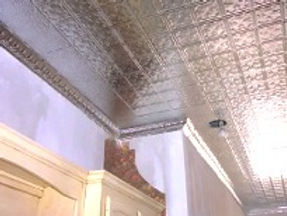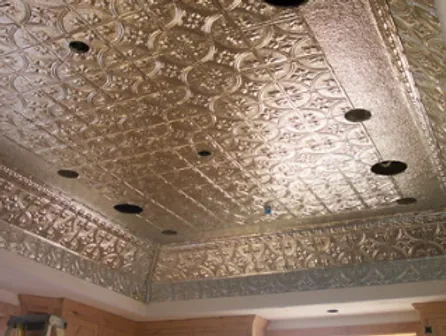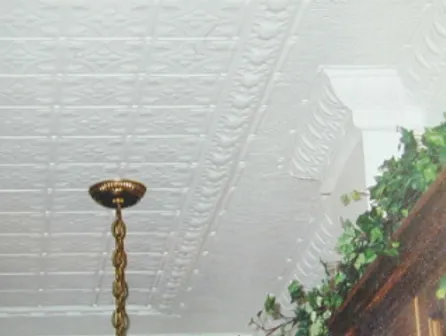Let's Talk About the Filler (2-01):
- thetinmanchelsea
- Feb 28, 2023
- 3 min read
Updated: Jan 23, 2024
The Filler is that bumpy, pebbly, nondescript design, that goes between, what we call the Face Plate (Design) and the crown molding (Cornice). Hence, the name “Filler”. It will sometimes help hide walls that aren’t straight, will give the design a nice clean edge and most of all, avoid the Cornice from landing on the middle of your design. The ceiling doesn’t look bad with the Cornice cutting into the design, but the Filler can make it look better. It usually cost the same because you are just trading out the number of sheets.

The Filler works best in square or rectangle rooms, but could be used in any room and at Chelsea, we will show you in a drawing of your project how it might look. Just send a diagram of your area with correct measurement. It’s one of the ways we help you, when you are considering a tin ceiling. The Filler should go underneath the Face Plate and the Cornice about an inch, so we try not to make the filler more than 22” showing. Sometimes it can’t be helped, but that is our goal for you. In the corners of the room we lay them out left or right having the seam face the wall and do not miter the corner, because that just makes a bigger seam. Nothing is in stone, but our rules are as follows:
Six Inch Designs: These designs aren't very deep, so the Cornice lays on the sheet almost

as well as on the surface of the Filler and because the 6” design is smaller pattern it doesn’t look bad if a design is cut in half by not using the filler. We don’t often recommend the Filler with that size pattern, but here is a ceilings with a 6" design and Filler.
Twelve Inch Designs: With these designs Filler could go either way, yes or no. Sometime the room will fit almost perfect without Filler, but in some cases the 12” design that you picked has a Filler look in the background and adds to the decorativeness of the room, although the Filler can be used with any design. Here is the 12-09, which has a filler like background, The wholes are for the light, which haven't been put in yet. This also shows you that light can fall anywhere and it will look fine.
The thickness of the design is deeper than the 6”, but if you are using tin Cornice, there is a flexibility to it, so it will still work without Filler. A wood crown might show gaps when laying over the design, it just depends on the angle from the floor.
Twenty Four Inch Designs: With these designs we recommend Filler because of the depth, since these are the deepest designs. The problem is, if the room isn’t square or rectangle it may have large uneven gaps of filler. If the design is going to hit the Cornice by, let’s say 3”, by removing that 24” square the Filler will be 21”, because that wall jetted out, but the rest of that wall had 12” of Filler. So it’s uneven. If a room is like that, our first recommendation is to go with a 12” design. We also recommend 24” designs when the ceiling is very high. That would also show less discrepancy in the uneven Filler.
Molded Filler: We also have a Molded Filler and I like to use that economically, meaning, if the filler is suppose to be 14” showing, that takes one sheet (2’ x 4’), but with the Molded Filler of 4”, (that's the narrow piece that surrounds the design), it will bring the Filler down to 10”, which means you can get two pieces out of a sheet (2) 1’ x 4’ pieces and save money because the Molded Filler is less and it adds to the look of the completed ceiling also. Molded Filler come 3 1/2” and 4 1/2” wide.
Another Benefit: As you can see the Filler helps the look of the ceilings by having the wall jetting into the space, not interfere with the main ceiling design. Remember: Keep looking up.



Comments